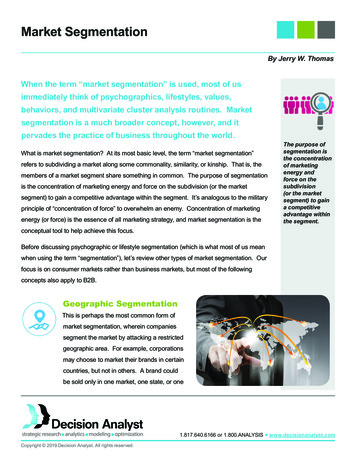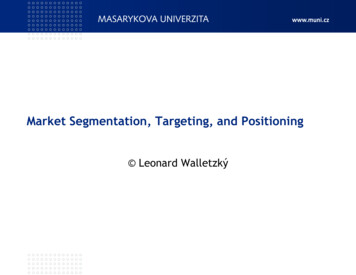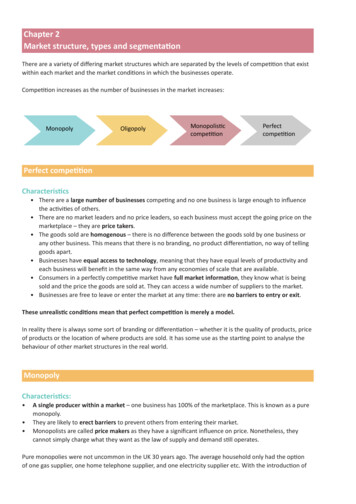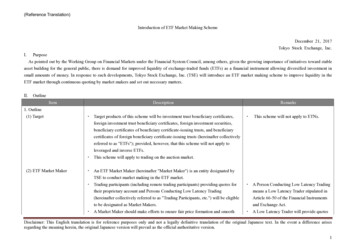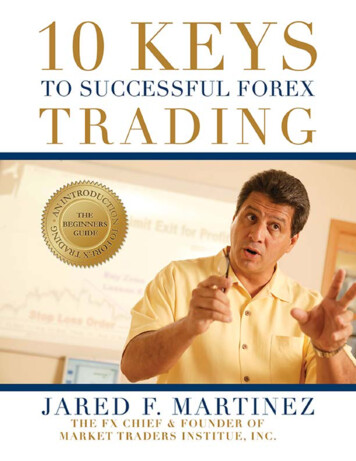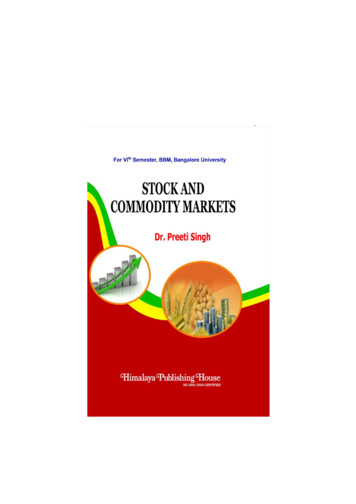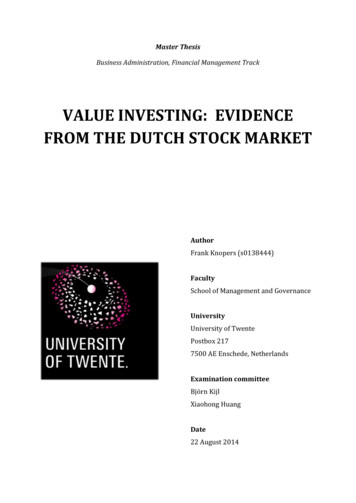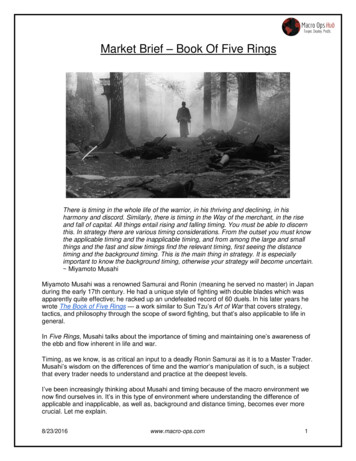
Transcription
Market Brief – Book Of Five RingsThere is timing in the whole life of the warrior, in his thriving and declining, in hisharmony and discord. Similarly, there is timing in the Way of the merchant, in the riseand fall of capital. All things entail rising and falling timing. You must be able to discernthis. In strategy there are various timing considerations. From the outset you must knowthe applicable timing and the inapplicable timing, and from among the large and smallthings and the fast and slow timings find the relevant timing, first seeing the distancetiming and the background timing. This is the main thing in strategy. It is especiallyimportant to know the background timing, otherwise your strategy will become uncertain. Miyamoto MusahiMiyamoto Musahi was a renowned Samurai and Ronin (meaning he served no master) in Japanduring the early 17th century. He had a unique style of fighting with double blades which wasapparently quite effective; he racked up an undefeated record of 60 duels. In his later years hewrote The Book of Five Rings — a work similar to Sun Tzu’s Art of War that covers strategy,tactics, and philosophy through the scope of sword fighting, but that’s also applicable to life ingeneral.In Five Rings, Musahi talks about the importance of timing and maintaining one’s awareness ofthe ebb and flow inherent in life and war.Timing, as we know, is as critical an input to a deadly Ronin Samurai as it is to a Master Trader.Musahi’s wisdom on the differences of time and the warrior’s manipulation of such, is a subjectthat every trader needs to understand and practice at the deepest levels.I’ve been increasingly thinking about Musahi and timing because of the macro environment wenow find ourselves in. It’s in this type of environment where understanding the difference ofapplicable and inapplicable, as well as, background and distance timing, becomes ever morecrucial. Let me explain.8/23/2016www.macro-ops.com1
As traders operating in markets we’re fighting in multiple timeframes. In these differenttimeframes there’s varying levels of signal to noise. We’re left to discern what timing isapplicable to our trade objective and what’s not. We need to learn from experience whichtimeframes we can have relevant conviction in and which we simply can’t.For instance, one cannot simply be bullish on stock XYZ. That is a meaningless statement. Areyou bullish on the stock over the short term (ie, next 4-8 weeks) because of factors a, b, and c?Or do you really think the company is undervalued and price should rise at some point over thenext couple of years; but you have no conviction on where it will go in the near term?Discerning your trade objective and reasoning is vital to understanding what your “relevanttiming” is. Meaning, you understand the relevant time and the factors applicable to your thesis— every timeframe has its own unique drivers.Musahi talks about the importance of “first seeing the distance timing and background timing.”The trading equivalent to these are price action and macro. Price action (distance timing)signals where things stand now and where they’re possibly headed in the near term (1-3months). Macro (background timing) tells us where the larger forces and imbalances are. Itprovides us with a gauge of where the risks and opportunities lie in the future. Both sections oftime affect one another, so the ebb and flow of the battlefield (market) is constantly evolving.But, as Musahi says, it is “especially important to know the background timing” because that isthe more powerful force that will eventually bend and dominate the near-term. It’s when thesedifferent timeframes line up that you get the most powerful and profitable trends.Livermore (the Musahi of markets) understood the importance of timing in speculation betterthan anybody and talked about this lesson repeatedly in Reminiscences of a Stock Operator:“The way to make money is to make it. The way to make big money is to be right atexactly the right time. In this business a man has to think of both theory and practice. Aspeculator must not be merely a student, he must be both a student and a speculator.”“There is a time for all things, but I didn't know it. And that is precisely what beats somany men in Wall Street who are very far from being in the main sucker class. There isthe plain fool, who does the wrong thing at all times everywhere, but there is the WallStreet fool, who thinks he must trade all the time. ““Obviously the thing to do was to be bullish in a bull market and bearish in a bearmarket. Sounds silly, doesn't it? But I had to grasp that general principle firmly before Isaw that to put it into practice really meant to anticipate probabilities. It took me a longtime to learn to trade on those lines. ““I think it was a long step forward in my trading education when I realized at last thatwhen old Mr. Partridge kept on telling the other customers, 'Well, you know this is a bullmarket!' he really meant to tell them that the big money was not in the individualfluctuations but in the main movements — that is, not in reading the tape but in sizing upthe entire market and its trend.”“.the point is not so much to buy as cheap as possible or go short at the top prices, butto buy or sell at the right time.”8/23/2016www.macro-ops.com2
“I had made a mistake. But where? I was bearish in a bear market. That was wise. I hadsold stocks short. That was proper. I had sold them too soon. That was costly. Myposition was right but my play was wrong.”“That is what happened. I didn't wait to determine whether or not the time was right forplunging on the bear side. On the one occasion when I should have invoked the aid ofmy tape-reading I didn't do it. That is how I came to learn that even when one is properlybearish at the very beginning of a bear market it is well not to begin selling in bulk untilthere is no danger of the engine back-firing.”Current “Distance Timing”According to the WSJ, the S&P’s realized volatility over the last 30 days has been lower than inany same such period in more than two decades. Volume has also been near record lows forthis time of year.As I write this (Tuesday morning) themarket looks like it’s finally breakingout to the upside of this range. If itholds, I’d expect to see someincreased bullish action going intothe start of next month.With the SPX trading at 2190, it’sbumping up against the significantlevel and round number of 2200.And according to Urban Camel, theSPX has had a “consistent tendencyto react as it nears each new “roundnumber” milestone for the first time.The smallest reaction (2%) was in2013 at 1800. Most often thereaction is more than 3%. The lasttwo were 10% (at 2000) and 6% (at2100).”I keep looking for price action weakness, but I fail to see it anywhere. The trend, though slow, isstill strong with this one. And most importantly, credit continues to get its perpetual bid. Until Isee sizable weakness in credit, I won’t look for a retrace.Yellen will be exercising her pie hole on Friday where she’s set to give a speech on Fed policyat Jackson Hole. There seems to be a renewed attempt to talk the market down in recent weeksby Fed officials; two of the Fed’s troika (Stanley and Dudley) have warned that a rate hike ispretty much imminent. So I wouldn’t be surprised to hear maybe a slightly more hawkish tonefrom Yellen, but historically there’s been little market moving news to have come out of JacksonHole.I don’t care to try and divine what the Fed will do or won’t do. I think it’s mostly a waste of time. Ihave my opinion, which is that they probably won’t get another hike in this cycle. But I won’t8/23/2016www.macro-ops.com3
attempt to trade off that opinion as my conviction levels are fairly low on its validity. MartinEnlund, of Nomura, wrote a good piece on the evolving optics at the Fed that you can find here.It’s worth a read.I get the sense that the market has largely written off the Fed’s jawboning. It’s not buying intothe threat of a rate hike. The Fed has burned through its forward guidance credibility and isgoing to either have to hike to regain narrative control or accept increasingly inflated assetprices and market complacency. The Fed finds itself in a catch-22, which Enlund from Nomuranotes well:At the risk of sounding as if we have, finally, lost our marbles, we feel compelled to add akicker: when was the last time the Fed talked seriously about financial stability? Risksentiment has recently been soaring, while hedge funds and the European pensionindustry appear to have jumped - or be jumping - headlong into EM currencies andassets. The difference between a grab for yield and a “dash for trash” is merely one ofdegree, and the Fed should definitely not seek the latter Looking at the record breaking flows in search of yield, I think it’s safe to say that we’re well intothe “dash for trash” phase.Though honestly, I don’t see this ending over the next few months. When large money flows intocredit like this, it tends to have very positive near-term impacts on both economies and markets.You guys hear us talk about liquidityall the time — it’s the most importantmarket driver — and this is strongliquidity.Just look at the Wu-Xia shadow ratesfor both the ECB and BoE below.The shadow rate shows the effectivecentral bank rate when rates dropbelow zero. The further it falls, themore stimulating it is to credit atleast to a point.8/23/2016www.macro-ops.com4
But if global markets — which are now more interconnected than ever — are going to have asustained rally, then we’re going to need to some improvement in European bank price action.And looking at Deutsche’s chart below, I think we might be seeing a temporary shift insentiment.Sentiment has been strongly negative on European financials lately, and rightly so. Their NIMs(net-interest margins) — the lifeblood of banking — have been squeezed out of existence bynegative rates. Some large banks are now actually exploring storing customer’s physicaldeposits (cash) in large vaults.Banks will be storing money under the mattress this is what we’ve come to.In the long-run, I don’t see how the ECB backs itself out of the NIRP trap. What they’re finding isthat NIRP is deflationary because it forces savers to save more. But Draghi has hinted at apossible increase in QE next month. This may be enough to shift the bearish sentiment for atime.Opec is meeting next month and we’re already hearing talk about a possible “productionfreeze”. This is a perfect example of the news being shaped by market sentiment. The marketwants to be bullish on oil, so the news interprets information as bullish.First off, OPEC is a dead organization. Any agreement reached would last as long as itbenefited each individual member. There is no loyalty to the group.8/23/2016www.macro-ops.com5
Secondly, a production freeze is meaningless because nearly all parties are pumping at recordlevels! So really any freeze near their max capacity would still be bearish with oil currently atrecord levels.With that said, I remain bullish on oilover the next month. And this isbecause of two reasons: [1] marketsentiment and liquidity are driving abullish narrative on oil that should lastuntil at least the OPEC meeting and[2] the almighty dollar still looks like it’sgoing to spike lower (we’ll cover this inthe tac section).Background TimingPaul Singer (hedge fund legend from Elliot Management) recently wrote in a letter to clients,that he now “regards the global bond market as ‘broken’ ”.He went on to say that we’re in “the biggest bond bubble in world history” and now “is in manyways the most peculiar period we have faced in 39 years”. And “One by one, traditional assetclasses are falling into realms of ‘un-investable’ and investors and savers are being forced totake ever more risk just to achieve a return the ultimate breakdown (or series of breakdowns)from this environment is likely to be surprising, sudden, intense and large”.This is the “Background Timing”. We cannot forget that we’re in the largest bond market bubblein history. As a devout economic history nerd; I’m in awe every day by what’s currently going onin markets. I have no doubt that in 50 years there will be whole chapters in economics booksdetailing the unbelievably stupid ignorance of policy makers during this time.Bonds sit at the top of the capital structure and their pricing affects everything on down toequities. I cannot conceive of any pleasant outcome for how this thing unwinds perhaps I’mjust not imaginative enough.But since it is the largest bond bubble in history it will probably go on longer than anybodyexpects it too. That’s just the way markets work. How long, I have no clue. All we can do isremain cognizant of the risk and keep a finger to wind.8/23/2016www.macro-ops.com6
Right now the data tells me we’re still in the middle to late stages of a credit cycle. So barringany exogenous shock, this market should continue to rise for at least another 3-6 months.The chart below which shows the unemployment rate advanced 2 years against corporateprofits suggest that margins should continue to contract as labor cost rise — labor makes up themajority of a company’s expenses.Real retail sales continue to stay positive; though only barely. This suggests that we shouldn’tsee recession until at least sometime next year.8/23/2016www.macro-ops.com7
Delinquency rate on consumer loans has started to tick up but is still well below the point whichusually signals recession is imminent. Of course, this is also being helped by record low interestrates.And then All Employees to civilian labor force (a fairly reliable recession indicator) is stillhovering above the demarcation line. Doesn’t look great but still slightly above its dangerzone.The distance timing (next 1-3 months) looks relatively good for markets. The background timinghowever is increasingly dangerous, and to quote Singer one last time, “Whilst this dynamic cankeep markets buoyant and, probably, encourage further gains, it is a dangerous game.”8/23/2016www.macro-ops.com8
Tactical (Head and Shoulders Everywhere)Here’s the logic chain in price action that I’m looking at the moment.The dollar still looks like it’s going to fall down.And if it does, it should fall fast due topositioning.If this happens it should push oil to complete itsH&S bottom pattern. And oil too would likelyexperience a swift sentiment driven runupwards.Higher oil prices will further boost the chase foryield or “dash for trash”, driving JNK bondshigher and emerging markets higher as well.One emerging market that I really like and think could experience a shift in sentiment soon isColombia.8/23/2016www.macro-ops.com9
Colombia has long had a bad rap for being the home of Pablo Escobar and suffering fromviolent FARC narco-terrorist during the “cocaine cowboy” days of the 80s and 90s. But anybodywho has been to that country in the last decade knows that times have changed for the better.Personally, it’s my favorite place to visit in Latin America.Not only has FARC been essentially dismantled and the drug trade mostly shifted to othercountries, but Colombia is also run by one of the most capable and pro-market governments inSouth America — behind Chile.Colombia has been hit hard, like all emerging markets, over the last two years due to thecollapse in commodities. Colombia is not highly dependent on exports — they only account for16% of GDP — but as Lat-Am’s 4th largest energy producer; oil accounts for just over half of allexport revenue. It’s estimated that for every dollar drop in the price of oil, the Colombiangovernment loses 200 million in state revenue.If the dollar and oil trades play out as I outlined above, then Colombia should see a significantshift in sentiment and price action over the coming months.Take a look at the USD/PESO cross below.The pair looks to be near completion of aH&S top. Meaning if it completes, the dollarshould fall and the peso appreciate. Thiswould be good for Colombian equities onmany levels.One of the ways I may want to play this,other than the above ETF, is through GrupoAval (AVAL) and Ecopetrol S.A.AVAL is Colombia’s largest financialservices company with a controlling stake infour of the country’s largest banks; as wellas its largest fund manager.Colombia has one of South America’shealthiest financial sectors and its bankingis largely oligopolistic; meaning the fivelargest banks hold over 75% of all bankingassets, enjoy close ties to the government,and thus have large moats to protect themfrom competition.AVAL enjoys healthy margins and a lowNPL (non-performing loan) ratio so that ifthere’s a continued shift in the macrooutlook — and I think there will be — thebank’s stock should recover to levels lastseen in mid-2015.8/23/2016www.macro-ops.com10
And then there’s Ecopetrol S.A., Colombia’s largest energy producer and refiner.This stock is a pure energy play. If oil doesn’t rise in the near-term then I don’t care to be in it.But if it does, then I think its advance will likely outpace crudes.EC recently completed an expensive modernization project on its largest refinery (Reficar). Theproject was plagued by cost overruns and typical Lat-Am corruption and scandal; which led to a100% cost increase to the tune of 8B. But now all of that’s behind it and the companypossesses the largest and most efficient refinery in Latin America — making it competitive withthe major refineries in the US (where it exports a lot of its product).With the major one-time capital expenditures out of the way, the company should see improvingmargins moving forward, bolstered by the better throughput efficiency of the modern refinery.If the dollar falls, oil rallies, and Colombia sees a shift in sentiment; then AVAL and EC shouldshoot the lights out. We will be adding positions here if there’s solid price action into the end ofthe week.I’m still keeping a close eye on shippers but haven’t been too impressed with their price-actionas of late but will continue to monitor.I really like the positioning in the Strategic Portfolio at the moment. MIFI has been terrific and itseems we took ⅔ profits at just the right time. I’ll look to add back to it if it comes down andtouches its 30-day MA. Stocks that shoot straight up like that, tend to correct even faster sowatch out.8/23/2016www.macro-ops.com11
I’m getting more and more bullish on natural gas plays. I really like CHK; and CRK is anotherone I’m looking at. We will probably be adding to our natural gas position towards the end of theweek.And lastly, I like the price action in sugar (SGG) and coffee (JO). These are volatile and toughinstruments to trade but can be extremely profitable if managed correctly. Timing of coursebeing the hardest component to get right.That’s all I’ve got for this week. Good luck in the markets and I’ll see you in the hub!-AlexPortfolio Snapshot8/23/2016www.macro-ops.com12
8/23/2016www.macro-ops.com13
wrote The Book of Five Rings — a work similar to Sun Tzu’s Art of War that covers strategy, tactics, and philosophy through the scope of sword fighting, but that’s also applicable to life in general. In Five Rings, Musahi talks about the importance of timing and maintaining one’


